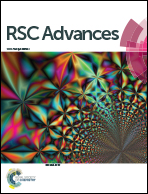Heterojunctions generated in SnO2–CuO nanocatalysts for improved catalytic property in the Rochow reaction†
Abstract
We report the improved catalytic performance of SnO2–CuO hybrid nanocatalysts synthesized by rationally designing and controlling the local heterojunction structure. The SnO2 nanoparticle (NP) decorated CuO nanorods (NRs) (SnO2–CuO) with a mace-like structure and with various CuO : SnO2 ratios were prepared via depositing pre-synthesized SnO2 NPs on CuO NRs in the presence of polyvinylpyrrolidone molecules. The CuO NRs were obtained by a facile hydrothermal reaction using Cu(NO3)2·3H2O as the precursor. The samples were characterized by X-ray diffraction, transmission electron microscopy, scanning electron microscopy, X-ray photoelectron spectroscopy, and temperature-programmed reduction analyses. The results indicated that in the SnO2–CuO hybrid nanostructures, the heterojunctions were well generated as the SnO2 NPs were well dispersed on the CuO NRs. Their catalytic performances were then explored via the Rochow reaction, in which solid silicon (Si) reacts with gaseous methyl chloride (MeCl) to produce dimethyldichlorosilane (M2). Compared to separate CuO and SnO2 as well as their physical mixture, the SnO2–CuO hybrids exhibit significantly enhanced M2 selectivity and Si conversion because of the enhanced synergistic interaction between SnO2 and CuO due to the generated heterojunctions. This work demonstrates that the performance of heterogeneous catalysts can be improved by carefully designing and controlling their structures even when their composition remains unchanged.


 Please wait while we load your content...
Please wait while we load your content...